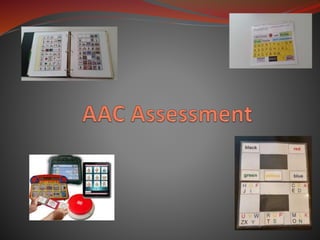
AAC Assessment
- 2. AAC Assessment is holistic and ongoing. Consider student’s abilities Current communication system Receptive language Literacy Consider the communication environments—home, school, work, leisure. Every AAC system is a work in progress! “Today vs. Tomorrow” (Beukelman & Mirenda 2013) Always honor the current communication system as you work on the new one.
- 3. Consider-- Communication partners—WE NEED THEM! They can tell us about the current communication system. They have background information about the student. They will be supporting the student’s current and future communication systems.
- 4. Barriers to communication Internal Speech, sensory and physical impairments Hearing test Functional Vision Assessment Cognitive impairments, Poor receptive language Learned helplessness, fear of failure External In the physical world In the attitudes and unexamined beliefs of other people
- 5. Background Information Medical Diagnosis Vision Hearing History of middle ear infections Languages spoken at home
- 6. Life Domains Home Family members Languages spoken by relatives School Projects and homework Extracurricular activities Leisure activity settings: Travel? Outdoor activities? Religious activities?
- 7. Motor Skills Gross Motor Walks independently? Uses a wheel chair Manual: self propelled or partner propelled? Power chair
- 8. Fine Motor Can the student Write? Draw? Point with an isolated finger? Use a standard keyboard? Point with the whole hand or fist? Use a pointer? Use eye gaze to point? Size of targets Spacing of targets
- 9. Current Communication System Receptive Language Can the student understand the speech of others? Can she follow directions without gestural or contextual cues? Does he require visual supports (pictures, gestures) to understand spoken information? Has she completed any formal language assessment? Some assessments can be adapted for non-speaking students Criterion based assessment
- 10. Current Communication Unaided Expressive Language Spoken words or word approximations Manual signs and natural gestures Intelligibility in context? With familiar listeners With unfamiliar listeners Ease of production Consistency of production Communication should be as effortless as possible!
- 11. Speech & Language Expressive Language (cont.) Manual signs Intelligible to unfamiliar communication partners who know basic signs? Intelligible to unfamiliar communication partners?
- 12. Pre-symbolic communication Vocalizations Gestures Facial Expressions Muscle tone
- 13. Behavioral Communication Tantrums Meltdowns Self injurious behaviors What is the message? I don’t want this. I want that. I’m overwhelmed. I need a break. I’m frustrated, angry, confused…
- 14. Written Language—the most complete AAC system ever! Reading skills Writing & spelling skills Reading and writing are basic human rights.
- 15. Feature Matching Identifying the client’s strengths or needs Matching them to the features available in various AAC tools: Language representation: Text to speech (with or without word prediction) Picture symbols—PCSs, Wigit symbols, Pictographs, Symbol Stix, Pixons, Bliss Symbols Photographs Braille, Morse Code Access method: eye control, touch screen, single switch, two switches Accessories: mounting system, pointer, key guard, sun shield, carrying case
- 16. Features: Speech Output Synthesized speech Allows users to generate unique spoken messages Appropriate to user’s age, gender and (in many cases) ethnicity Delivered at consistent pace and volume Doesn’t sound like a real person Digitized speech • Each message is recorded individually • Great for singing Happy Birthday, telling jokes, making animal noises and vocal interjections (Ahem! Ha! Doh!) • Not consistent, rarely age and gender appropriate.
- 17. Features: No Speech Output Technology free means: You can drop it, throw it, get it wet! Never needs recharging! Sometimes users get more social attention and face to face interaction with tech free modes of communication. PECS—Picture Exchange Communication System Communication book Eye gaze board Alphabetic Encoded w/ auditory scanning Picture based
- 18. Features: Keyboards Alphabetic, QWERTY, Dvorak or organized for scanning Adapted keyboard—larger size; one handed 5-finger typing On screen keyboard Word prediction Sentence prediction Size of text
- 19. Features: Switch Access Scanning methods: Automatic scanning Step scanning (with one or two switches) Inverse scanning Row column, sequential (linear), rotary, block, other Scanning mode—auditory, visual Type of switch—button style, wafer, sip and puff, pillow, squeeze, proximity, motion sensing Switch access point—hand, head, chin, foot….
- 20. Features… The list Just Keeps Growing…..
- 21. But that’s ok! The road is long.
Editor's Notes
- Everyone communicates. Everyone communicates differently in different environments. Everyone regresses under stress.
- Sometimes a person can speak intelligibly when they in good health and are not under stress. At other times they may need help.
- Just expect change and hope that the best is yet to come!
